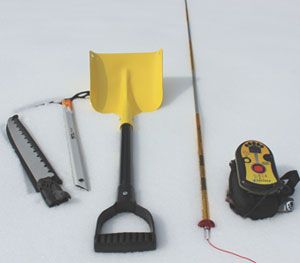Editor’s Note: The following column is part of our TacticaList series, a collection of expert columns and features on all things tactical — from fishing and hunting to camping and shooting. These columns are featured in our monthly TacticaList newsletter. Check out our most recent issue and let us know what you think! Click here to subscribe to the TacticaList.
For many, March represents the end of winter. In Colorado, it’s the heaviest snow month annually and avalanche danger soars. Though I’m not an avalanche expert, my area of operations often included avalanche paths during searches, rescues, or recoveries, so I dedicated myself to learning about the threat they posed.
The sheer power these natural events demonstrate is humbling and alarming. If you are operating in avalanche terrain there are a few things you can do to minimize your risk.
Build Your Knowledge
Learn about avalanches, what they can do, what they look like, and what triggers them. There are roughly 30 fatalities caused by avalanches every year in the states. The majority of victims are back-country skiers, but snowmobile operators have given them some close competition lately.
Avalanches happen naturally in the mountains, but are sometimes triggered by people. What happens then depends on many factors. Avalanches are not freak accidents; they’re more akin to a weather phenomenon.
Snow builds in the high mountains whenever it’s cold enough to freeze and stay there. Some high elevations in the country maintain snow all year long. The snow is affected by atmospheric conditions: sun, wind, and temperature all play a role.
Imagine a somewhat thin layer has been worn out by intense sun, then gets five feet of wet, heavy, snow dumped on it in a short time. Depending on conditions, this new layer may not bond well to the original. Say that snow has fallen on a slope that is between 35-45 degrees, and the terrain creates a natural bowl with a long tapering run down the mountain, perhaps a few thousand feet. The instability, coupled with the terrain has dramatic potential. Now add an errant snowmobiler or skier to the mix and disaster ensues.
So how do avalanches kill you? If you aren’t killed outright by being smashed into trees, rocks, or thrown over a cliff, the snow, which may reach 60-80 MPH, will quickly overwhelm and bury you.
When the avalanche stops, it hardens fast. Avalanche survivors have reported that they had no idea which direction was up, and they were completely unable to move, some unable to even blink. If you survive the initial ride, you eventually suffocate, breathing in your own carbon dioxide because it has nowhere to vent out in front of your face.
Here are some great resources to expand your knowledge on avalanche safety:
1. Staying Alive In Avalanche Terrain by Bruce Temper is a wonderful book and can greatly build your understanding of avalanches as well as help you build a good decision-making model to deal with the risks.
2. The Avalanche Handbook by David McClung and Peter Schaerer.
3. Go to an avalanche school. Nothing replaces this valuable hands-on training and experience. There are some great schools in the areas most affected by avalanches, and a little bit of knowledge goes a long way. You will learn physical skills associated with avalanche mitigation, and also learn how to read the conditions of snow and assess risk.
Learn How to Avoid Them
The best possible advice anyone can give you about avalanches is to avoid them completely. Everything short of that opens you up to varying degrees of disaster.
Go to www.avalanche.org, where you can learn the avalanche conditions in your area. Colored maps are available to indicate the severity of risk.
If you must cross terrain with avalanche potential, think about mitigation. Try to avoid the high-risk range of 35 to 45-degree slopes. Avalanches change the landscape and leave evidence behind. Look for obvious signs of a previous run like a lack of trees (or new grown ones). Stick to ground that has good anchor points like many tall trees. Above all else, if it looks remotely dangerous, don’t risk it.
Gear Up
A good deal of technology has been developed to help us survive avalanches. Here are a few good tools to have on you:
 |
| Pictured left to right is a Black Diamond Snow saw, Petzl Ice axe, Voile snow shovel, G3 Speed Pro probe, and Backcountry Access Tracker DTS Beacon. (Photo courtesy Sean Curtis) |
1. Beacons — People who operate in this terrain use beacons, small devices attached to the body that emit a locatable signal. If an avalanche falls and buries people, anyone with a beacon capable of finding the signal can search for the missing. Chances of success vary on the number of people available to search, the size of the slide, and other needed equipment. (Pictured is a Backcountry Access (BCA) Tracker DTS Beacon).
2. Probe poles — Probe poles are carried to help locate victims. These collapsible poles can extend to roughly ten feet long and jam into the snow. When they hit something solid and stop, you may have found a victim. Poles work best in conjunction with a systematic line search comprised of several people. (Pictured is a G3 Speed Pro Probe)
3. Shovels — Once located, the victim must be dug out of the snow as fast as humanly possible. Avalanche shovels are sturdy, packable, and can move snow quickly. With any luck, you can expose the victim’s head in order to allow them fresh air. After being dug out, an avalanche victim may have multi-systems trauma and be suffering from hypothermia. Things can get exponentially more challenging if multiple people are buried and few people are available to rescue. Also keep firmly in mind that one avalanche does not mean the mountain is done. Another from even higher is sometimes a risk to rescuers. (Pictured is a Voile Avalanche snow shovel)
4. The Black Diamond® Avalung is a device worn on the body that has a mouth tube located near the face. It’s designed for the avalanche victim to bite down on the tube and keep it in their mouth. Once buried, the victim breathes through the tube which does two things: it pulls in fresh oxygen from an intake box and expels the CO2 behind the victim — extending the survivable bury time.
5. Air bags — Perhaps the most exciting line of products consists of air bags. Scientists studied how different sized particles behaved during an avalanche, some falling slower and “floating” more than others. Through this work, airbags were developed that operate much like an airbag in a car. These bags start out collapsed in a backpack. They are deployed by the wearer and stay inflated. Their value lies in providing much needed buoyancy to the wearer and preventing them from being buried, or at least, being completely buried. Black Diamond®, Backcountry Access, Mammut, and Ortovox offer these products.
Avalanches are both beautiful and terrible to behold. If this dangerous event lurks in your area, you owe it to yourself and your companions to get educated. Attend a school, read books, and use local forecasting websites to plan your trips. Keep avoidance in the forefront of your mind, plan your routes carefully. Get the minimal equipment of a beacon, shovel, probe pole and learn how to use them. The other specialized equipment can be expensive, but an insurance policy that can save your life is invaluable.



